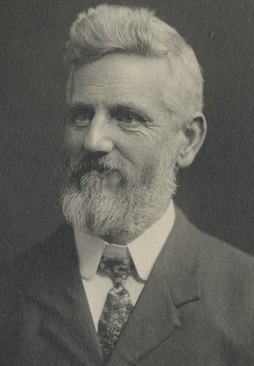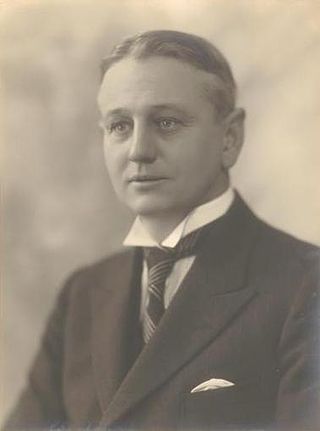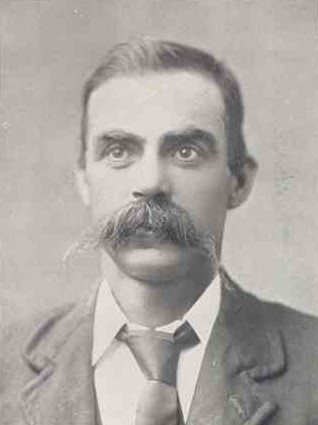Related Research Articles

Charles Cameron Kingston was an Australian politician. From 1893 to 1899 he was a radical liberal Premier of South Australia, occupying this office with the support of Labor, which in the House of Assembly was led by John McPherson from 1893, and by Lee Batchelor upon McPherson's death in 1897.

Egerton Lee Batchelor was an Australian politician and trade unionist. He was a pioneer of the Australian Labor Party (ALP) in South Australia, which at the time was known as the United Labor Party (ULP). He was a member of the South Australian House of Assembly (1893–1901), leading the ULP from 1898 until his resignation in 1899 to accept a ministerial post in a non-Labor government, with the party's approval. Batchelor entered federal politics in 1901 and held cabinet posts in the first three ALP governments. He was Minister for Home Affairs (1904) under Chris Watson, and then served two terms as Minister for External Affairs under Andrew Fisher. He suffered a fatal heart attack at the age of 46 while climbing Mount Donna Buang.

Norman John Oswald Makin AO was an Australian politician and diplomat. He was an Australian Labor Party member of the Australian House of Representatives from 1919 to 1946 for Hindmarsh, from 1954 to 1955 for Sturt, and from 1955 to 1963 for Bonython. He was Speaker of the Australian House of Representatives from 1929 to 1932 and served as Minister for the Navy, Minister for Munitions (1941–1946) and Minister for Aircraft Production (1945–1946) under John Curtin, Frank Forde and Ben Chifley. He was the first President of the United Nations Security Council in 1946, and served as Ambassador to the United States from 1946 to 1951.

Crawford Vaughan was an Australian politician, and the Premier of South Australia from 1915 to 1917. He was a member of the South Australian House of Assembly from 1905 to 1918, representing Torrens (1905–1915) and Sturt (1915–1918). Elected for the United Labor Party, he served as Treasurer in the Verran government, succeeded Verran as Labor leader in 1913, and was elected Premier after the Labor victory at the 1915 state election.

Thomas Price served as the South Australian United Labor Party's first Premier of South Australia. He formed a minority government at the 1905 election and was re-elected with increased representation at the 1906 election, serving in the premiership until his death in 1909. It was the world's first stable Labor government. Shortly afterwards, John Verran led Labor to form the state's first of many majority governments at the 1910 election.

George Edwin Yates, often referred to as Gunner Yates, was an Australian politician. He was an Australian Labor Party member of the Australian House of Representatives from 1914 to 1919 and from 1922 to 1931, representing the electorate of Adelaide.

Ernest Alfred Roberts was an Australian politician and soldier who was a Labor member of the South Australian House of Assembly from 1896 to 1902 and 1905 to 1908 and then the Australian House of Representatives from 1908 to 1913. Roberts also served as an officer in South Africa during the Second Boer War, with South Australian colonial forces in 1900 and Commonwealth forces in 1902. From 1904 to 1908 he was the editor of The Herald, a left-wing newspaper published by the United Labor Party (ULP).

Reginald John Burchell was an Australian politician. He was a member of the Australian House of Representatives for the seat of Fremantle from 1913 to 1922, initially for the Australian Labor Party and after the 1916 Labor split for the Nationalist Party.

John Lloyd (Jack) Price was an Australian politician and trade unionist. He was an Australian Labor Party member of the South Australian House of Assembly for Port Adelaide from 1915 to 1925. He later served in the Australian House of Representatives for Boothby from 1928 until his death in 1941, but left the Labor Party and joined the United Australia Party, following the 1931 Labor split over government responses to the Great Depression.

Joel Moses Gabb was an Australian politician. He was a member of the Australian House of Representatives from 1919 to 1934, representing the electorate of Angas. He represented the Australian Labor Party until resigning during the 1931 Labor split; however, he did not join the United Australia Party along with the other dissident MPs, and instead remained in parliament as an independent.

Edgar Rowland Dawes was an Australian politician. He was a Labor Party member of the South Australian House of Assembly from 1930 until 1933, representing the electorate of Sturt. He was the leader of the official Labor Party in South Australia in the aftermath of the 1931 Labor split from May 1932 until his defeat at the 1933 state election.

Henry Chesson was an Australian politician. He was a member of the South Australian House of Assembly from 1905 to 1918, representing Port Adelaide until 1915 and West Torrens thereafter. He represented the United Labor Party until being expelled in the 1917 Labor split, and thereafter represented the splinter National Party until his defeat at the 1918 election.
The Herald was a weekly trade union magazine published in Adelaide, South Australia between 1894 and March 1910; for the first four years titled The Weekly Herald. It was succeeded by The Daily Herald, which ran from 7 March 1910 to 16 June 1924.
The Parliamentary Labor Party was a political party active in South Australia from August 1931 until June 1934.
The National Party was a political party active in South Australia from 1917 to 1923. As with the federal National Labor Party, it was created in the wake of the Australian Labor Party split over conscription, resulting in the February 1917 expulsion from the South Australian Labor Party of the Premier, Crawford Vaughan, and his supporters. It was initially known as the National Labor Party like its federal counterpart, but was renamed at a conference in June 1917. The party initially continued in government under Vaughan, but was subsequently defeated in parliament in July 1917, and thereafter served as the junior partner in a coalition with the Liberal Union under Archibald Peake.
The Lang Labor Party was a political party active in South Australia from 1931 to 1934, aligned with Lang Labor and the policies of Premier of New South Wales Jack Lang.
This is a list of members of the South Australian House of Assembly from 1915 to 1918, as elected at the 1915 state election:
This is a list of members of the South Australian House of Assembly from 1899 to 1902, as elected at the 1899 colonial election:
This is a list of members of the South Australian House of Assembly from 1896 to 1899, as elected at the 1896 colonial election:
Francis Bernard Keogh was an Australian politician who represented the South Australian House of Assembly multi-member seat of West Adelaide from 1901 to 1902.
References
- 1 2 "History of South Australian Elections 1857 - 2006 Volume 1: ECSA". Archived from the original on 2 March 2014. Retrieved 14 January 2016.
- ↑ "WEST ADELAIDE". The Advertiser . Adelaide. 3 June 1901. p. 9. Retrieved 14 January 2016– via National Library of Australia.
- ↑ "WEST ADELAIDE". The Register . Adelaide. 3 June 1901. p. 6. Retrieved 14 January 2016– via National Library of Australia.
- ↑ "Various Views". The Critic . Adelaide. 8 June 1901. p. 4. Retrieved 14 January 2016– via National Library of Australia.